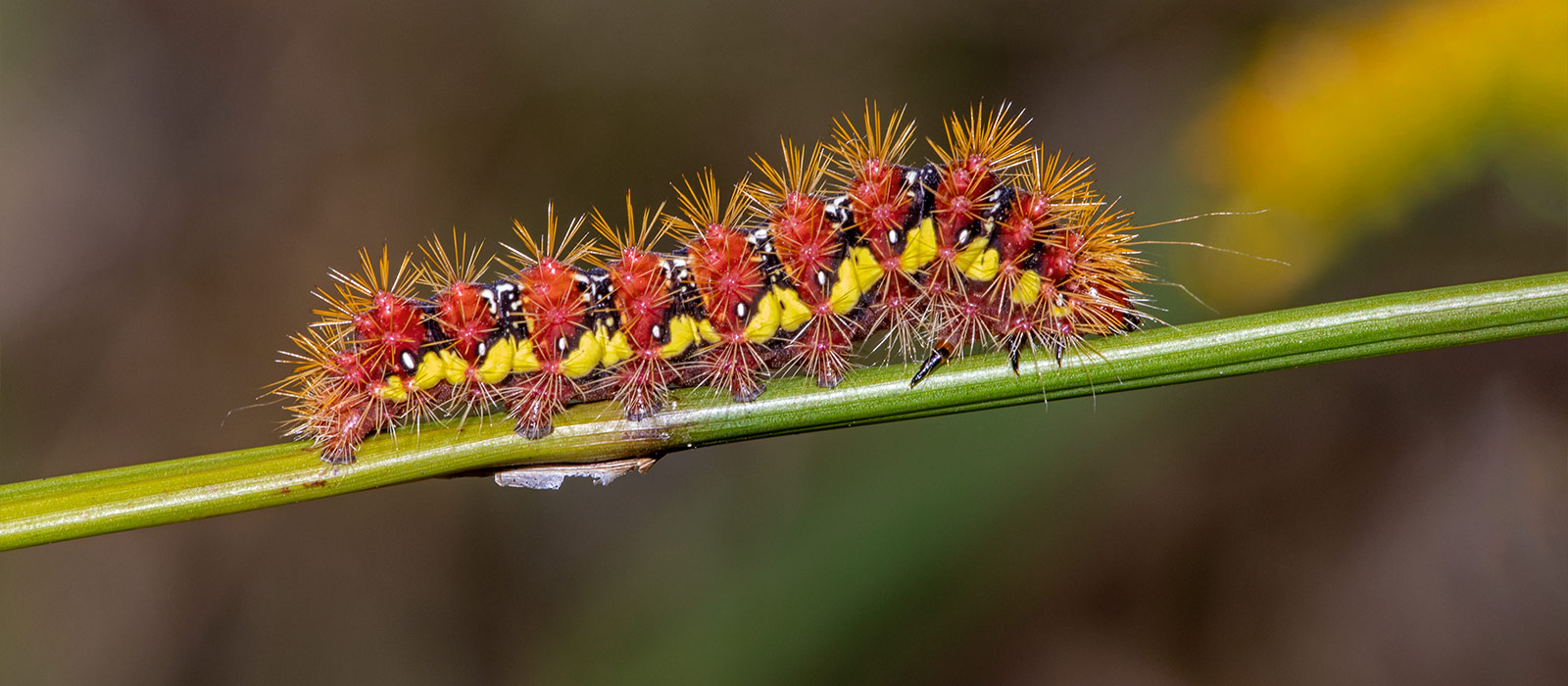
Defiance and Disguise
Creativity Among Caterpillars (Well ... Evolution, Actually)
Charles Darwin himself was once confused about caterpillars — the gaudy ones didn’t quite make sense.
According to his own theory of sexual selection, dazzling colors and armaments on animals evolved in part to give males an aesthetic or competitive edge in the ruthless arena of courtship and mating. Yet because caterpillars, as the immature form of moths and butterflies, neither court nor breed, Darwin sought an explanation for the ornamentation and weaponry many of them display.
For an answer, he turned to his colleague and collaborator on evolutionary thought and theory, Alfred Russel Wallace, who did indeed have a hypothesis: “warning coloration.” It was already known at the time that many caterpillars were unpleasant, unpalatable or toxic to birds and other predators. Wallace suggested that a toxic caterpillar would do well to be distinctive, memorable, a bad culinary experience easily learned by a predator. Being a recognizable threat would work well for the predator and prey alike (and even the prey’s mimics).
“Large numbers of animals, more especially insects, are gaudily coloured, either with vivid hues or with striking patterns, so as to be very easily seen,” Wallace wrote in 1889. “Now it has been found, that in almost all these cases … the brilliant or conspicuous colours or markings serve as a warning or signal flag against attack.”
Everything about this caterpillar says, “Don’t mess with me.”
I got my own signal flag when I encountered that Smeared Dagger Moth (Acronita oblinita) above while photographing butterflies in Maine on Tuesday. Everything about this caterpillar says, “Don’t mess with me.” So much so that these and other “aposematic” caterpillars often rest without apparent concern in plain sight.
But before I reveal a crazy thing about the Smeared Dagger Moth, consider another caterpillar now out in force here in Vermont: Maple Leafcutter Moth (Paraclemensia acerifoliella). Find some shrubby Sugar Maples — you might not at first see the beast that lies within, but rather its dinner plate and hideout. The Maple Leafcutter cuts a disc of leaf and hides beneath it to feed on maple tissue largely undetected, except for telltale brown patches where it dined or actual holes where it had cut out its discs (like a hole-punch).
Because caterpillars grow as they eat, Maple Leafcutters outgrow their leafy refuges (even though they don’t grow much longer than 5 millimeters or so). In my image above, note on the right the tiny caterpillar barely emerging from its hideout to cut a larger disc in preparation for another round of binge-eating. Maple Leafcutters actually reside most of the time sandwiched between two discs — like a pita bread — or, as a biologist call it, a “habitaculum.” By any name, it’s not a bad hideout from warblers and other songbirds hunting the trees for a caterpillar meal. After all, those birds aren’t eating ornamental, spiky caterpillars like my Smeared Dagger Moth and its ilk.
Over the years, I’ve conducted various desktop experiments with Maple Leafcutters. Once, for example, I flipped a leaf disc to find the caterpillar with only half its pita in place. I wondered whether it could right itself like an overturned turtle. It did indeed, and soon began to cut out what would become the other half of its shelter. Or bring a bunch of those maple leaves indoors, and soon enough you’ll see little green discs patrolling your walls.
Soon the Maple Leafcutters now in our woods will descend along tree trunks, still in their protective casings, or flutter in free-fall to the forest floor. Within its habitaculum, the caterpillar will spin a silken cocoon, pupate and spend the winter. In May, as the Sugar Maple leaves break from their buds, adult Maple Leafcutters emerge to fly free as tiny moths with steel-blue wings and an orange head. They’ll mate, and the females will lay eggs on fresh maple leaves to complete the cycle.
The adult Maple Leafcutter is more flashy than its caterpillar. But that’s not always the case among moths. To the contrary, many of our most ornate and celebrated caterpillars are rather dull as adult moths. After all, if you’re a moth, it makes sense to broadcast your toxicity when you are most vulnerable to predators — as a caterpillar on a plant rather than an adult flying free at night when songbirds and other predators (except for bats) aren’t as active.
In addition to commandeering a plant’s toxins as defense, moth caterpillars display a range of survival skills: they can resemble twigs or snakes or bird droppings, be covered in unpalatable hairs or spines, or even evert a forked “osmeterium” (not unlike a snake’s tongue) that wafts odd odors toward a predator.
So here you have it — the other crazy thing about the Smeared Dagger Moth I found in Maine is how utterly plain it becomes as an adult. See it below, along with a few other examples of two amazing transformations — not only from caterpillar to flying moth, but from the ornate to the ordinary.
Oh, by the way, Darwin really liked Wallace’s hypothesis on those showy caterpillars: “You are the man to apply to in a difficulty,” he reportedly wrote back to his colleague. “I never heard anything more ingenious than your suggestion, and I hope you may be able to prove it true.”
Other Seasonal Reading
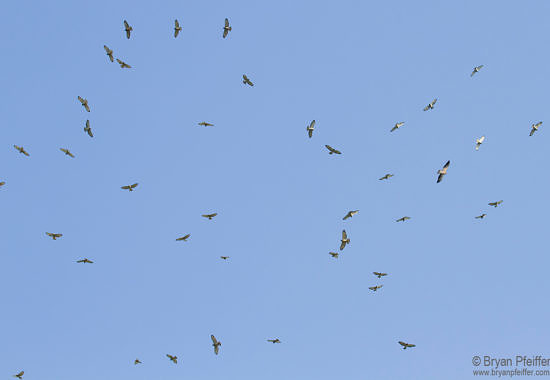
Hawkwatching Confidential
The fall hawk migration is upon is. Here's some advice for novice hawkwatchers.

The 2019 Monarch Migration Forecast
The forecast calls for Monarchs. Migration is now underway.

Going Nuclear for Dragonflies
Birds aren't alone in the skies of migration. Dragonflies are on the move as well.
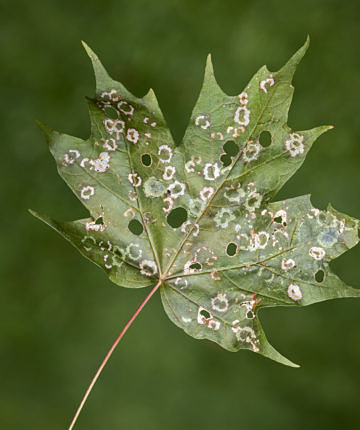
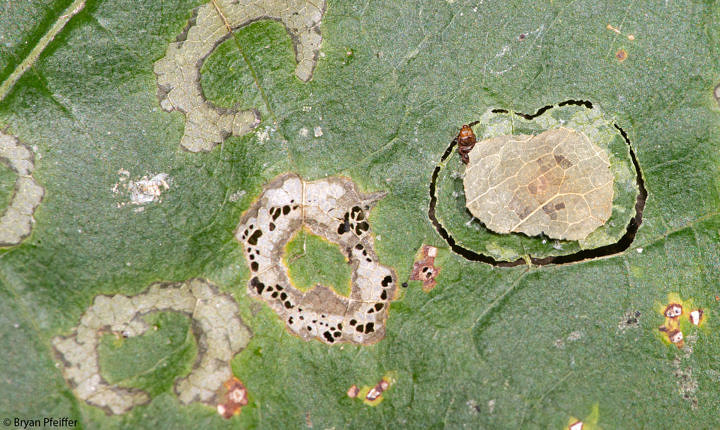
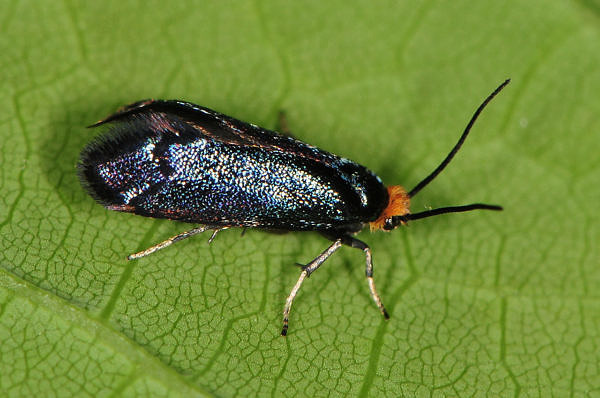
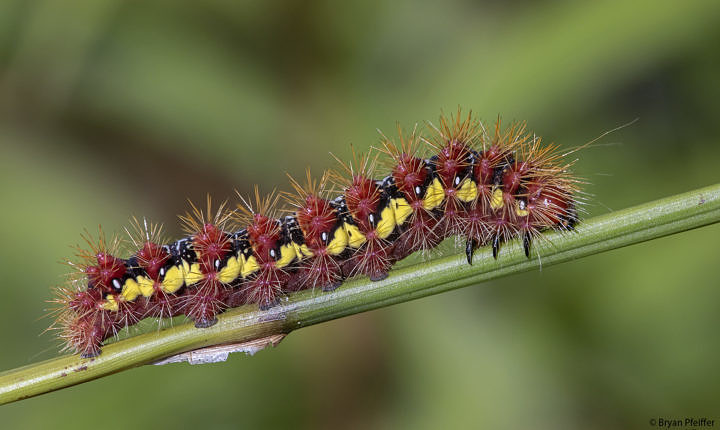


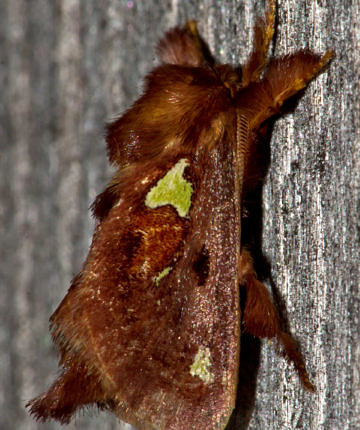
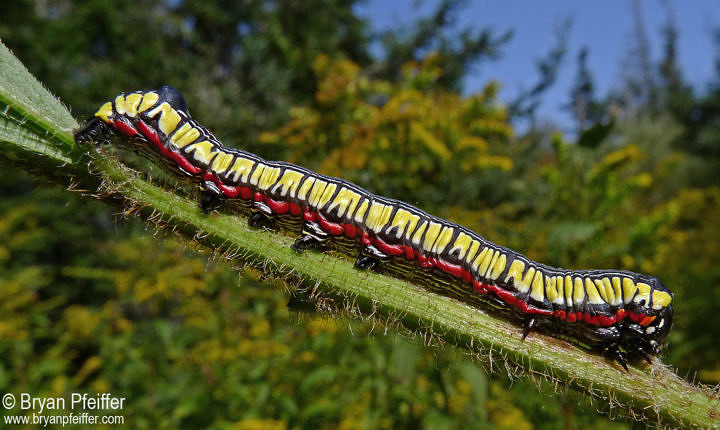
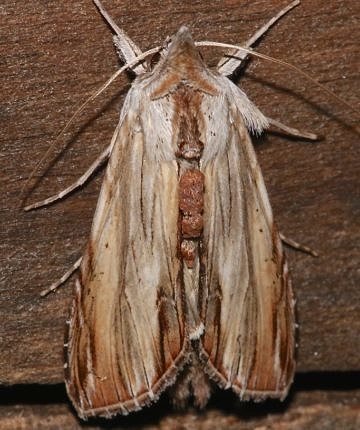



Thanks for the report, Brian. (And thanks to the dogs as well. 🙂 )
Thanks, Juan! It’s great to hear from you. We gotta catch up somehow. I’m curious to hear about your own recent adventures. 🙂
Bryan- this is another one of your wonderful articles and as usual very informative. Thanks.
This is great. Thanks, John. Yeah, now is the time for those larvae to “migrate” to earth. I’ve been planning to watch them. More than anything, I want to get photos of them “marching” around the forest. As it turns out, if the larvae in their little “pitas” fall prematurely off a tree, they can climb back up the trunk to resume feeding. But, for the most part, they flutter to earth, rather than climb down on their own.
I’m on a mission this week! Keep me posted!
Thanks for the report, Brian. I’ve just learned of a massive Monarch flight at Point Pelee this past weekend. Quite a spectacle along that lake there. Southeastern Ontario are my old stomping grounds — wonderful diversity there.
Thanks, Brian!
Great article, Bryan. I understand what I’m seeing now on maples in Hubbard Park and elsewhere. Also, I was watching a red squirrel through binocs last year in Hubbard and it appeared to me as though it was feeding on maple leafcutter larvae where they were concentrated in a maple tree. As the squirrel was moving about, the leaf discs were fluttering down to where i was watching from. Can’t say for sure, but that is what it appears was happening.
Enjoyed this column. Am spending my first year on a rural property, seeing many, many new (to me) moth caterpillars than ever before. Another good example of drab moth/brilliant caterpillar is the white-marked tussock moth. Most mind-blowing on both fronts was the Pine Imperial Moth caterpillar I found (well, my dogs found it rooting in the lawn, I rescued/moved it). On butterfly front, giant swallowtails are everywhere, I have pics of 2 and 3 on same flowers. Great year for Monarchs as well. (I’m in southeastern Ontario.)
Great read and stunning shots Bryan!
Thanks, Tony!
So do I, Nancy. So do I. 🙂
This is so kind of you. Thanks so much, Katie. You’ve made my day. Yes, please do indeed enjoy all those “little things” — so many of them around us.
Thanks, Linda!
Thanks, Ann. Lots of moth caterpillars to choose from — typically 15- to 20-times more diverse than butterflies. Enjoy!
Hi Ginny,
What a wonderful report (your spiny encounters notwithstanding)! Ouch — I’m particularly sorry to hear about that yellow jacket encounter. But I do think Ios may well be worth that irritation.:-) What a spectacular insect. And, yes, it’s been a good summer for Giant Swallowtails. Lots of them in the Champlain Valley of Vermont right now. They’ve become a resident butterfly here, as I suspect they are near you as well if they can find plants in the citrus family (Rutaceae) — yeah, we’ve got some up here — for laying eggs.
Thanks again for checking in!
Hi Carol,
Those small white fuzzy caterpillars are quite possibly Hickory Tussock Moth (Lophocampa caryae). Send a photo! 🙂
I don’t remember ever seeing as many caterpillars and spiders as there have been this summer ….Have also never seen the small white fuzzy caterpillars that seem to be around this year….and dangling from the trees as well as being on the ground..
Bryan – another timely post! I walked out on the porch with my morning coffee today and found a caterpillar curled up in a circle. He was a beautiful greenish yellow color with a narrow red stripe from front to back. He had yellowish spines all along his back. After looking him up in my caterpillar book, I discovered he is an io moth. I also read that the spines can inflict a string like reaction. I’m glad I knew that before I carried him down to my woods. Sure enough, as I was putting him on a branch, he started to fall and I grabbed him just a little too tightly. I definitely felt those spines!! I quickly developed red welts. After he had a secure grip on the tree branch, I went in and washed my hands. The welts and stinging sensation quickly dissipated. They were far more tolerable than the yellow jacket sting I got the day before!! I would love to see the io moth as an adult someday with their big “owl eyes” on the wings. They’re really very pretty. Another quick note – I’ve been enjoying a stunning Giant Swallowtail Butterfly for the past week in my Zinnias. Quite a few people on the Northern NY Birdlist had mentioned seeing them for the first time. Most of these folks were located in eastern NY near the VT border. Needless to say, I was thrilled to have one here.
Take care, Bryan, and thanks for another fantastic article and beautiful photos.
Ginny
Cleveland, NY
Great article, fantastic photos – I am a caterpillar groupie now.
Very fun and interesting read!
Bryan, as always a very interesting read. I so enjoy your articles because they not only are interesting, but they widen my perspective on the little things we take for granted. These little living creatures have a complete life and I am too lazy to look up and find out what they are and what their lives entail. You supply this information in a wonderful and easy explanation of what these creatures are and what your interaction with them was. Thanks so much for taking the work out of my learning.
I always learn so much from your posts, Bryan!
A great post! Thanks